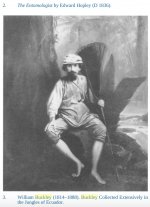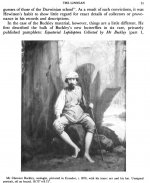Björn Bergenholtz
(former alias "Calalp")

But the second part of your post #19 is far more relevant (for me that is) and truly thought-provoking ...
In A Guide to the Archives of the Royal Entomological Society (2002) we find the claim that the guy on the portrait is William Buckley (1814–1888) versus Vane-Wright in The Linnean (1991), that says the same guy is Clarence Buckley [that we now, thanks to Jan, know was born in 1832]. Both attached below, for comparison.
If the date for this portrait "c.1870", as given in Vane-Right's Paper, is correct (and I see no reason to doubt it) ... I would say that the painting itself tend to support Vane-Right (as being a portrait of Clarence Buckley).
The general impression, after once again having looked at the features and details of the Portrait, I somewhat doubt that the depicted guy is his mid-50's ...
I sure wonder how the Entomologists came to that conclusion (eleven years after Vane-Right's Paper). What news, contradictory facts had/has turned up? Or is this some kind of mix-up? Two Buckley, both in Ecuador, in about the same years, both collecting butterflies (and birds?). Odd, but so it seems.
However; at this point, simply to be on the safe side, I will put a question mark regarding the Identity of the depicted Buckley. Before having read the 2002 Paper in full (which I haven't) I wouldn't dare to claim either way.
On top of this there are several features in this Portrait/Painting (artistic style, pose, characteristics of the period, etc., etc.) indicating that it might be a portrait done on commission, in a studio, far from Ecuador, based on an (even earlier) portrait ... ? I´m not even all convinced it's Mr Buckley's body we see!
I´m sure looking forward to read the 2002 piece in full.
I will return to this matter, onwards, when times allow, at this moment I'm too busy with other etymologies, but if somebody beat me to finding (or already have read) the 2002 Paper, please enlighten us on how they came to the conclusion that the Portrait represent William (and not Clarence) Buckley.
One or the other is clearly wrong.
Björn
PS. But I would like to think (read; hope) it's a Portrait of "our" Clarence! If so I would love to use it (if allowed, of course) to illustrate my MS. Dear William seems to be of minor interest (that is; in ornithological etymology). At least as far as we know today ...
--
That's sharp-eyed, Martin! A correct observation ... I hadn't seen this contradiction/incompatibility before. Thanks! :t:
In A Guide to the Archives of the Royal Entomological Society (2002) we find the claim that the guy on the portrait is William Buckley (1814–1888) versus Vane-Wright in The Linnean (1991), that says the same guy is Clarence Buckley [that we now, thanks to Jan, know was born in 1832]. Both attached below, for comparison.
If the date for this portrait "c.1870", as given in Vane-Right's Paper, is correct (and I see no reason to doubt it) ... I would say that the painting itself tend to support Vane-Right (as being a portrait of Clarence Buckley).
The general impression, after once again having looked at the features and details of the Portrait, I somewhat doubt that the depicted guy is his mid-50's ...
I sure wonder how the Entomologists came to that conclusion (eleven years after Vane-Right's Paper). What news, contradictory facts had/has turned up? Or is this some kind of mix-up? Two Buckley, both in Ecuador, in about the same years, both collecting butterflies (and birds?). Odd, but so it seems.
However; at this point, simply to be on the safe side, I will put a question mark regarding the Identity of the depicted Buckley. Before having read the 2002 Paper in full (which I haven't) I wouldn't dare to claim either way.
On top of this there are several features in this Portrait/Painting (artistic style, pose, characteristics of the period, etc., etc.) indicating that it might be a portrait done on commission, in a studio, far from Ecuador, based on an (even earlier) portrait ... ? I´m not even all convinced it's Mr Buckley's body we see!
I´m sure looking forward to read the 2002 piece in full.
I will return to this matter, onwards, when times allow, at this moment I'm too busy with other etymologies, but if somebody beat me to finding (or already have read) the 2002 Paper, please enlighten us on how they came to the conclusion that the Portrait represent William (and not Clarence) Buckley.
One or the other is clearly wrong.
Björn
PS. But I would like to think (read; hope) it's a Portrait of "our" Clarence! If so I would love to use it (if allowed, of course) to illustrate my MS. Dear William seems to be of minor interest (that is; in ornithological etymology). At least as far as we know today ...
--
Attachments
Last edited:





